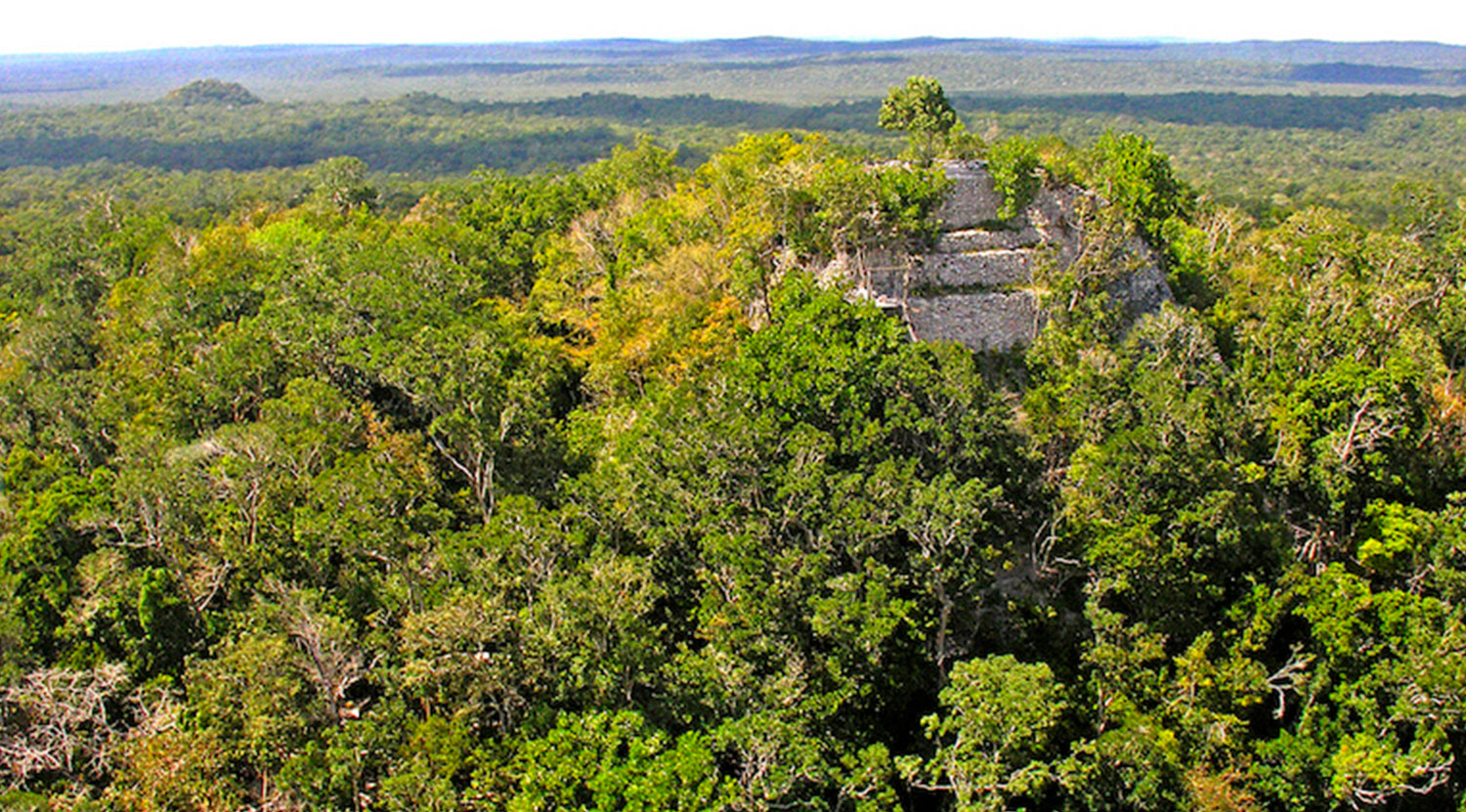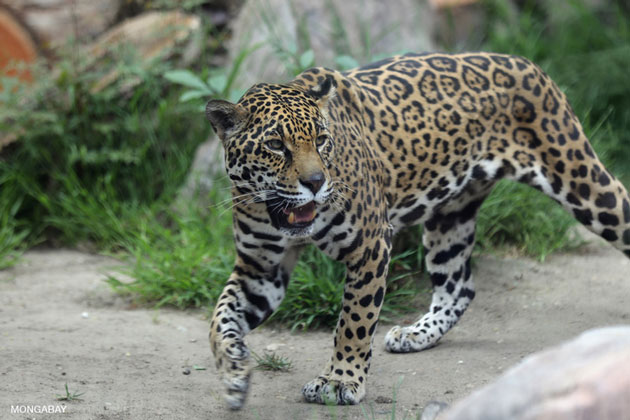In Guatemala, refugees find new calling as park rangers

- In recent years, the number of migrants and refugees entering Guatemala after fleeing violence at home has grown.
- FUNDAECO, a local conservation NGO, has partnered with UNHCR and other groups to find jobs for some refugees working as park guards in Guatemalan biodiversity hotspots.
- Fifty-five refugees have been employed in the “Green Jobs” program so far, with FUNDAECO hoping that number will reach at least 100.
At night in Mirador National Park in northeastern Guatemala, Raul Gomez falls asleep surrounded by the calls of nocturnal animals padding their way through the jungles of the Maya Biosphere Reserve. Gomez is a ranger there, helping to keep poachers and loggers out of the remote park — one of Guatemala’s most pristine — which is home to jaguars, harpy eagles, and the sprawling ruins of once-mighty Mayan cities now enveloped by vines and greenery.
It’s a far cry from Gomez’s life as a bricklayer just two years ago, when he had to go on the run from his village in Honduras after local maras (gang members) delivered him an ultimatum: join us, or die.
Gomez, whose real name is not being used to protect his identity, is one of hundreds of thousands of migrants to have arrived in Guatemala in recent years, a key transit country along the journey to the U.S., where they hope to find safety and new lives. Some, like Gomez, are fleeing violence or political persecution. Others are being pushed north by climate change or seeking better economic opportunities.
For decades, the U.S. had a system in place to sift through asylum claims and determine which ones met the legal criteria under the 1951 Refugee Convention. But harsh immigration restrictions imposed by the Trump administration have made the process nearly impossible, and a new rule issued in the early days of the COVID-19 pandemic essentially closed U.S. borders to migration of any kind.
For many migrants, returning home isn’t an option, and it’s easy to fall through the cracks of shaky asylum systems in Guatemala and Mexico if they decide to stay there.
‘Green jobs’ for refugees
Marco Cerezo is the director of FUNDAECO, a Guatemalan NGO that works in conservation projects and national parks across the country. The group also assists forest communities in obtaining legal titles to their land. To support some of those communities, they set up a network of small clinics that offer sexual and reproductive health services to local women.
Four years ago, Cerezo began to notice that large numbers of migrants were passing through areas where the clinics were located. As their numbers grew, the U.N. High Commissioner for Refugees (UNHCR) reached out to FUNDAECO to ask if they could partner in using the clinics to provide services to migrant women who were heading north.
“Just by pure coincidence, our working sites are along the migratory path for refugees coming from Nicaragua and Honduras,” Cerezo said. “But also — and we’ve been learning a lot about this — refugees that travel from Cuba, Africa and Brazil up through Colombia and into Guatemala.”
FUNDAECO agreed to work with UNHCR, eventually proposing a program to help find jobs for some refugees in Guatemala.
“The idea was to offer them the capacity to resettle, and to provide a solution for people who fled conflict or human rights violations and can’t go back home,” Alexis Masciarelli, a Guatemala-based communications officer with UNHCR, told Mongabay in an interview.
Eventually, the idea developed into a program called Empleos Verdes (“Green Jobs”), where FUNDAECO and another local organization agreed to place candidates in jobs working in conservation and environmental management.
“When you speak with people who were able to find a job, not just working on a day-to-day basis, but something more regular, it brings back their dignity and their capacity to contribute to a new community and feel more settled, which is what most people want,” Masciarelli said.
Gomez was in the first wave of refugees to be referred by UNHCR to FUNDAECO for one of the jobs. Honduras has struggled with endemic gang violence in recent years, and after receiving death threats Gomez fled to Guatemala, crossing the border with less than $5 to his name. A bus driver in a border town took pity on him and brought him to Petén, the Guatemalan state where the Maya Biosphere Reserve is located.
With the help of UNHCR, Gomez was hired to work as a ranger in Mirador National Park. To prepare, FUNDAECO ran him through an intensive training program where he learned to identify local species, set up camera traps, and move quietly through the jungle. Parts of the Maya Biosphere near Mirador have lost sizeable tracts of forest to slash-and-burn farming and cattle ranching in recent years.
Now, Gomez spends up to two weeks at a time inside the park, working with a team of more experienced rangers to track down illegal loggers and poachers.
“At first it was hard, I wasn’t adapted to the environment,” he told Mongabay in an interview. “But as time went by I got more comfortable. You get attached to the place and sometimes when you’re among the landscape you don’t even want to leave.”

The lucky few
Gomez is now one of 55 refugees who have been hired by FUNDAECO through its collaboration with UNHCR. Some work in remote parks, like Gomez, and others in wooded ravines that thread through Guatemala City and are sometimes referred to as the city’s pulmones, or lungs.
“Most of them are park guards,” Cerezo said. “And some are working in maintenance of protected areas, [fixing] trails and stuff like that. Others are working in ecotourism.”
Sensitive to the perceptions of some Guatemalans who might be resentful at seeing migrants hired instead of them, FUNDAECO hires one local for every refugee it places in a job.
“They work together, and the idea is they become friends, meet their families, and kind of support each other,” Cerezo said.
Cerezo said he hopes that eventually the nascent program will hire at least 100 refugees in total. Still, that number is just a small fraction of the migrants who pass through Guatemala or have been forced to stay there due to border restrictions. According to Masciarelli, officially there are just over a thousand asylum seekers hoping to settle in Guatemala.
“Although the number has increased in the last four or five years, it’s still quite limited at the moment,” he said. “We have in the country around 1,200 refugees and asylum seekers.”
Unofficially, though, the number of refugees in Guatemala is likely to be far higher, with many not showing up on the formal rolls. The bulk of migrants tend to head north, but Guatemala’s asylum system is underfunded and has been criticized by human rights groups for being incapable of cataloging and processing everyone who wants to make a claim for protection in the country.
For the lucky few who have found their way into the green jobs program, an unexpected doorway has opened up into Guatemala’s natural world. Where once they may have been forced to trek through dense jungles during arduous journeys out of harm’s way, now they protect the forest from intruders.
“I feel super grateful because I never thought I would have such a beautiful opportunity,” Gomez said. “To take care of the Maya Biosphere is something amazing. When you come from another country you don’t think you can have an opportunity like this, and when I did I was speechless.”
Cerezo said he hopes the program will expand and serve as a model for what rebuilding Guatemala’s economy after the COVID-19 pandemic could look like.
“We need a green recovery with green jobs,” he said. “Refugees and asylum seekers can support us in that.”
This article first appeared on Mongabay.







